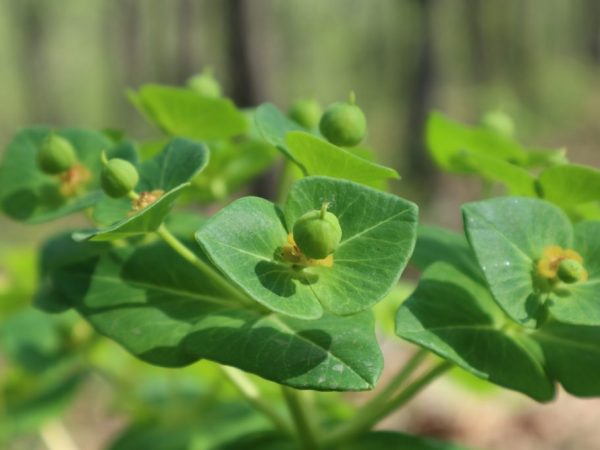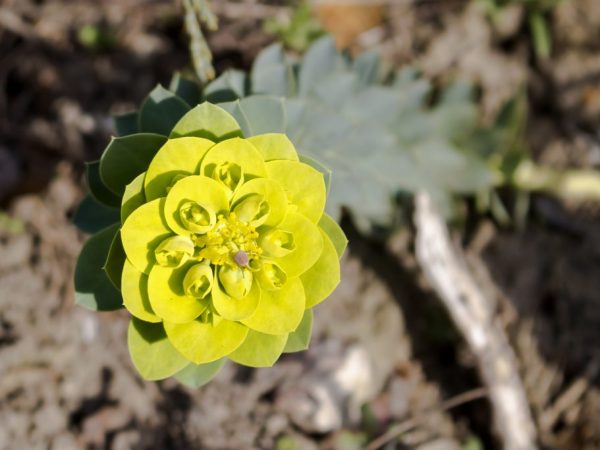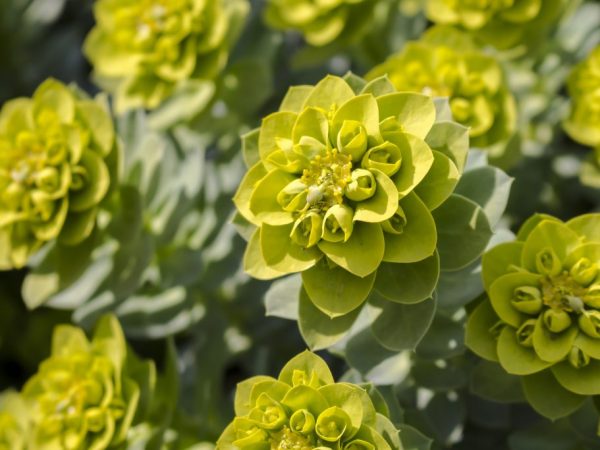Pallas spurge - useful properties
Pallas (Fischer's) spurge has long been known in alternative medicine for its wide range of beneficial properties. It is poisonous, but together with toxic substances it contains many unique natural components that have benefits for human health.

Pallas spurge - useful properties
Botanical characteristic
The plant is perennial. It grows on stony or crushed stone soils, much less often in flat steppes in areas well-lit by the sun.
The homeland is considered to be the steppe zones of Mongolia and China. On the territory of Russia, it is distributed in Eastern Siberia.
It is quite rare, has a conservation status and is included in the Red Data Books of a number of regions.
For its resemblance to a human figure and the ability to heal male diseases and increase sexual performance, Pallas's euphorbia was named the root man.
Artificial cultivation is mainly associated with obtaining useful raw materials for use in traditional medicine. But it has no official recognition in the medical industry.
For many gardeners, Euphorbia is a weedy vegetation.
Description:
- the stem is erect, with a bare or pubescent surface, height up to 0.4 m, when cut or mechanically broken, it emits poisonous milky juice, the length of the upper internodes is up to 6 cm;
- leaves are narrow, scaly, elliptical or oblong lanceolate, elongated, saturated green color, matt surface, grow from the base of the stem, the lower tier is much darker than the upper ones, with a brown tint, triangular at the ends, collected in whorls of 2-3 pieces;
- number of peduncles - 5;
- inflorescences are located in the crown of the shoots, the shape is umbrella-shaped, the color is yellow, the flowering period is in the spring;
- fruits in the form of a triangular flattened thick-walled capsule, the number of seeds is 3 pcs., the color is light brown;
- the root system is well developed, formed by thick branches extending to a great depth (from 1 m and longer), on the cut it emits a white especially burning milky juice, in appearance the roots are similar to ginseng, but differ in the largest sizes.
Features of collection and procurement
There is an already harvested and dried product on sale. The average price for 10 g is about 100 rubles.
The raw materials can be collected by yourself. The main places of growth of Pallas milkweed in Russia are in Siberia and Altai. It grows in small quantities in the middle lane.
For medicinal purposes, only the root of the plant is suitable, the aerial part is not collected. It is harvested from the end of August and throughout September, when there is a general wilting of the leaf mass.
Herbalists believe that plants from 3 years or more are of the greatest value - their roots are quite developed, they have sprouted to great depths and received from the soil layers numerous nutrients that are inaccessible to other vegetation.
Basic procurement rules:
- when collecting poisonous grass, they use gloves that protect the skin, avoiding the ingress of milky juice on the skin, the mucous membranes of the oral cavity are covered with gauze masks, the eyes - with goggles;
- digging up the roots begins around the perimeter of about 0.5 m from the place of growth of the base;
- the root system is harvested completely, incl. undeveloped branches;
- the prepared raw materials are washed from the remnants of the earth under running water and dried naturally, spreading them out in a thin layer and placing them in a place well-lit by the sun, stirring occasionally to avoid decay;
- brown bark on the rhizome is left because it is it that contains the bulk of the nutritional components, only fragments exfoliating from the root are removed;
- dried root shoots are cut into small pieces.
Useful elements
The chemical composition of milkweed contains useful components: flavonoids, coumarins, tannins, steroids, anthracenes, saponins, organic acids, resins.
Selenium accounts for the bulk of the aboveground part.

The plant contains many useful substances
At the root, there are phytoexysteroids and phytoandrogens important for men's health - natural substitutes for sex hormones that are actively used to treat inflammatory processes in the prostate gland, restore erectile dysfunction and normalize hormonal balance.
Medicines have complex healing properties:
- act as a strong immunostimulant;
- serves as the prevention of malignant neoplasms in oncology, stopping the further development of metastases;
- endowed with analgesic, antibacterial and wound-healing properties, which make it possible to shorten the treatment time for open lesions of the skin;
- fights against pathogenic microorganisms - bacteria, viruses;
- increases sweating and excretion of bile;
- is a prevention and a way to cure fungal infections;
- contains tonic and regenerating ingredients and slows down the processes of natural aging;
- improves the quality of the digestive system;
- heals the respiratory system;
- it is used to restore female reproductive function and treat mastopathy, fibroids, cysts and fibroids;
- cleans blood vessels, improves blood circulation and prevents the formation of thrombophlebitis;
- helps to get rid of cosmetic skin problems.
Recipes and schemes of use
Euphorbia is crushed for the preparation of infusions and decoctions.
The second option is to grate it, grind it in a mortar or grind it in a coffee grinder to the smallest particles in the manufacture of tablets and powders.
The plant is used as an adjunctive therapy. The classic course duration is about 1.5-2 months.
Infusions
Traditional medicine often recommends water infusions for the treatment of female diseases (fibrosis, cysts, fibroids, infertility) and restoration of male health (prostate adenoma and impotence).
Recipe:
- 10 g of crushed root is poured with boiled water (1 l);
- the container is covered with a lid and wrapped to create heat, kept for 0.5 hour;
- the infusion is filtered.
Application scheme: 1-2 tbsp. per day after 0.5 hours at the end of a meal at intervals of 3-4 times at regular intervals.
Reception in small doses is indicated for cleansing the circulatory system, removing toxins and heavy metals, and curing urolithiasis.
Outwardly, the medicinal infusion is used as lotions and baths - to relieve joint and muscle pain, relieve pain syndromes, with exacerbation of gout and inflammation of the lymph nodes.
Decoctions
The proportions of milkweed and water for the decoction are similar to those taken for infusions. The difference in cooking - the mixture is boiled for ¼ hour on low heat, and then insisted for 2-2.5 hours and filtered.
Scheme of use: 1 tbsp 0.5 hour after a meal at intervals of 2-3 times a day.
Decoctions are suitable for the treatment of inflammatory processes of the upper respiratory tract, help against bronchitis and tuberculosis, bronchial asthma.
They are also prescribed as adjunctive therapy for cancer recovery and chemotherapy.
Powders

Milkweed root boosts immunity
Powdered root is used as a tonic and immunity-enhancing agent. A small amount, about 0.03 g (at the tip of a knife), is poured over with water. Drink three times a day.
This form of treatment also serves as a highly effective natural antiseptic and is suitable for restoring damaged skin as part of lotions or dry. The frequency of treatments is up to 2 times a day.
Pills
At home, tablets are prepared from the root with honey, the components are taken in a 2: 1 ratio, mixed thoroughly and formed into balls with a diameter of about 5 mm.
They are taken to increase immunity and to normalize heart function, maintain blood pressure stability and strengthen blood vessels.
Scheme: 2 tablets 3 times a day, 0.5 hours after a meal.
Alcohol tinctures
The most popular way to prepare euphorbia for treatment is to make an alcoholic tincture. It is suitable for outdoor and indoor use and has a long shelf life.
It is used against joint diseases, with exacerbations of gastric ulcers, rheumatism, inflammation in the respiratory system, osteochondrosis, and as a prophylactic against ARVI in spring and autumn.
Recipe:
- 10 g of dried root is poured with 0.5 ml of alcohol with a strength of 70%;
- put for 14 days in a cool, dark place;
- the mixture is filtered.
They drink the tincture in courses depending on the severity of the disease:
- 1 course. On the first day - 1 drop three times a day after meals. On the next day, the dose is increased by 1 drop, bringing it to 30 by the end of the month. Then they drink the tincture in the reverse order of decreasing (1 drop less daily). The duration of such treatment will be 2 months.
- 2 course. It is indicated for severe forms, more often recommended for the treatment of oncological neoplasms. Begin in a similar manner, 1 drop per day, but the initial dosage is 15 drops. The duration of therapy is a month.
In order to reduce excess weight and normalize the functioning of the digestive organs, you can drink milkweed infusion on alcohol from 1 to 2 months - 8-10 drops three times a day after meals.
Ointment
From the powder, you can prepare an ointment for external use, which serves as an effective treatment for cosmetic skin defects and dermatological diseases.
It is made on a fat basis - interior lard, petroleum jelly, lanolin, and zinc and salicylic creams are also used for the base.
Ointments with milkweed lighten pigmented areas, remove warts and soften calluses and corns.
Contraindications
The plant is not used in pharmacology, therefore, before using it for medicinal purposes, you should consult a doctor.
Among the restrictions:
- tendency to allergic reactions;
- pregnancy and lactation;
- childhood;
- patients with low blood clotting.
Potential harm
The chemical composition of the man-root contains the poisonous substance euborphin, which has a toxic effect. If used incorrectly, milkweed-based products, this component can cause adverse effects and be harmful to health.
The use of infusions and decoctions on an empty stomach often provokes bouts of nausea. They can also have a significant effect on the stability of the hormonal background.
The first signs of poisoning:
- disruption of the digestive tract;
- acute pain in the stomach;
- burning sensation in the mouth;
- bouts of vomiting.
In case of an overdose, you should consult a doctor, and before that:
- rinse the stomach with an aqueous solution of baking soda with a concentration of 2%;
- take absorbents such as activated carbon.
The poisonous milky sap of the plant, if it gets into the eyes, can cause temporary blindness for up to 1 week. In contact with mucous membranes, it causes a chemical burn. It is washed off with plenty of running water, sterile dressings are applied and a doctor is consulted.

